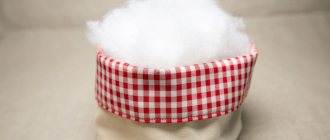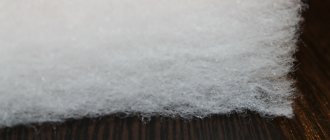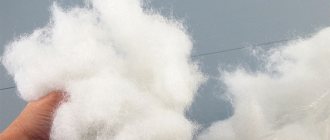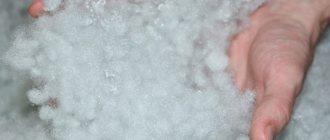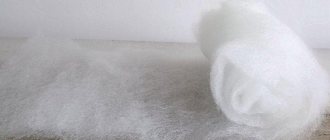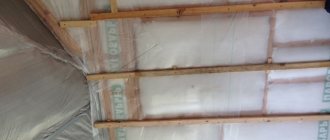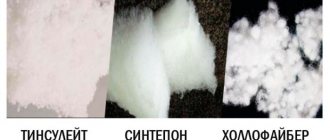Holofiber - what is it?
The name holofiber is well known. However, for most people it remains a mystery what kind of insulation this is. First, let's clarify how to spell it correctly: holofiber, halofiber or hallofiber?
According to the Wikipedia dictionary: Hol-lo-fi-ber is a synthetic non-woven material made of hollow fiber used as filler or insulation.
The name of the material is written with an “o” and two “ll”. The English phrase “hollow fiber” is taken as a basis. It was patented by Russia (Moscow nonwoven materials plant Termopol), although the development was carried out by South Africa. Holofiber was intended to be the best version of padding polyester - non-clumping, lighter and warmer.
Holofiber, what kind of material?
This is a non-woven material based on spring-like hollow polyester fibers. This trademark was registered in 2005. The method for producing this fiber was developed at. The material has cavities sealed on both sides, thanks to which the final material receives its useful characteristics.
Available in several types:
- Canvas;
- Layer (slab);
- Twisted "balls".
The shape depends on the area of use. Linen is most often used as insulation for outerwear, but holofiber in balls is simply irreplaceable as a pillow filler. Construction is another area of application for this material. Slabs would be the ideal option here. Construction holofiber insulation retains heat in a room without creating a “greenhouse” effect.
primeneniya-hollofaybera-3
primeneniya-hollofaybera-4
primeneniya-hollofaybera-5
primeneniya-hollofaybera-6
Description
To understand what kind of material holofiber is, let’s take a close look at it:
As you can see in the photo, the material consists of the finest hollow hairs. They are curled and hold their shape well.
Most often, holofiber looks like a non-woven white fabric of different thicknesses and densities, rolled into a roll.
But there are other release options:
- FEC. Pinkish insulation with limited flame spread. Used for sewing winter clothes for oil and gas workers.
- Balls (Puffs). Filler in which holofiber fibers are twisted into small balls and spirals. Used for filling pillows, blankets, toys, soft furniture items.
- Volumetric. High-volume filler that gives an “airy” shape to products. Used in handicrafts, production of goods for newborns, three-dimensional furniture and clothing.
- Software Soft, elastic and elastic holofiber in rolls. Serves for insulating outerwear: jackets, overalls, coats, winter pants.
- Medium and Hard. Dense and hard types of material. They can be supplied in slabs and rolls. In demand in the production of mattresses and upholstered furniture.
- Build. The walls are insulated with holofiber. It is environmentally friendly, does not interfere with air circulation, absorbs noise and has high thermal protection.
Compound
Holofiber is made from polyester fiber - virgin polyester. This is a completely synthetic material.
Composition: 100% polyester.
Today, different technologies for the production of holofiber are used. Classic method:
- The thinnest polymer threads, hollow inside, are pulled from the melt of polyethylene terephthalate.
- The resulting primary loose fabric is cut and combed in special units.
- Next, the material is formed into balls or layers using a powerful air flow.
- Finally, the fibers are soldered together at high temperature (about 180 degrees). The treatment reduces the mobility of the fibers.
The material is highly environmentally friendly; no glue or other chemicals are used in its production.
The fibers can additionally be twisted into springs. This material is called holophane. It is characterized by increased wear resistance and retains heat better. Also improved holofiber are polyfiber, thermofiber and fibertek fillers. Their fibers are thinner, lighter and even more tightly twisted. Thermofiber has extremely low thermal conductivity.
Sometimes the terms “Yupifiber” and “nolifer” are used for holofiber. However, such varieties are unknown to modern science. “Nolifers” are people who do not see real life, living in illusions and games.
Characteristics
As is known, from the general principles of the action of insulation, porous materials, which include holofiber, do not heat, but retain heat. The fibers contain air chambers that create a layer with a low thermal conductivity coefficient. The synthetic shell prevents moisture from displacing air. This combination makes the material very warm. It continues to retain heat even in damp conditions.
Characteristic:
- soft;
- elastic;
- lasting;
- easy;
- heat-insulating properties – high;
- breathable;
- hypoallergenic;
- easy to care for;
- affordable;
- resistant to moisture, does not attract dust;
- does not smell and does not absorb odors;
- fireproof.
The material melts, but no acrid smoke or soot is released. When exposed to fire and intense heat, the polyester base cokes. Holofiber takes its original shape even after prolonged and strong compression. It is not interesting as a food source for insects, fungi, and bacteria.
The conditional disadvantages of the filler can be considered a higher price than that of padding polyester, low hygroscopicity and the presence of high-tech analogues.
Softness
High-quality padding polyester - soft to the touch, quite elastic and dense. The surface of the canvas is always smooth. The surface of low quality padding polyester may be covered with a light crust. You should not buy such material, it will be hard and quickly lose its properties.
See also: How is World Elephant Day celebrated?
Holofiber is much softer than padding polyester, it is light, silky to the touch and quite loose. The surface of holofiber is never smooth, and the presence of a crust on this material is excluded.
Comparison with other insulation materials
Today, many materials, both natural and synthetic, are used as insulation. To understand what place holofiber occupies among them, we will conduct a small comparative analysis of the most popular materials.
Comparison table between holofiber and natural down:
| Holofiber | Natural fluff | |
| Purpose | Variable conditions, dampness, mountain tourism, water trips | Dry conditions, city, extreme altitude |
| Weight | +- | + |
| Thermal insulation | +- | + |
| Compression | +- | + |
| Breathability | +- | + |
| Moisture resistance | + | — |
| Insect resistance | + | — |
| Resistance to bacterial contamination | +- | + |
| Allergenicity | + | — |
| Volume recovery rate | + | +- |
| Price | + | — |
| Durability | + | +- |
Down was and remains an ideal insulation material, but despite all its advantages, it is an allergenic material that is difficult to care for and produce. To insulate their clothes, they need a special, down-retaining fabric. Holofiber is devoid of these disadvantages and is much cheaper.
Comparative table of holofiber and modern synthetic fillers:
| Holofiber | Sintepon | Isosoft | Thinsulate | |
| Weight | +- | — | + | ++ |
| Thickness | +- | — | + | ++ |
| Compression | +- | — | + | ++ |
| Thermal insulation | +- | — | + | ++ |
| Breathability | +- | — | + | ++ |
| Moisture resistance | +- | — | + | ++ |
| Price | + | ++ | +- | — |
| Durability | +- | — | + | ++ |
Holofiber is on the next level after padding polyester, but loses to other modern synthetic fillers - isosoft, thinsulate and others.
What temperature are holofiber jackets suitable for?
A question that concerns many people: are holofiber jackets warm or not? Definitely yes! But how much depends on the density of the holofiber. It can vary from 60 to 4000 g/m² (in clothes up to 600 g/m2).
- 60-100 g/m2 – warm autumn (from +15 to +5 degrees).
- 100-150 g/m2 – cold autumn, warm winter (from +5 to - 5-10 degrees).
- 200-250 g/m2 – winter (temperature -10-15 degrees).
- 300-400 g/m2 – frosty winter (from -20 to -30 degrees).
- over 500 g/m2 – extremely low temperatures (from -35 degrees).
How warm a holofiber jacket will be also depends on the lining material and outer fabric. The use of fleece and membrane allows you to achieve better thermal protection with a lower insulation density.
Reviews
Products with holofiber receive mostly positive reviews:
Artemis:
“I bought a jacket from Kapre with holofiber. I liked the look and cut. There is quite a lot of filler, about 5 centimeters thick. I wear it over a thin sweater in winter and I don’t feel cold at all. The only thing is that in strong winds you feel discomfort.”
Kate:
“Halofiber jackets are only good for spring and autumn. In winter, there is nothing better than a down jacket and a fur coat. In terms of price, they are, of course, incomparable."
Victoria Romanovna:
“I have both pillows and blankets made of holofiber. They are very helpful, since the whole family is allergic to bird fluff. They are also incredibly light, soft, and wash well. In the cold season, it’s very warm and cozy under such a blanket.”
What is made from holofiber
The manufacturer's assortment includes more than 1000 material formulations for domestic needs and industry. Varieties differ in density, structure, appearance, and shape. These can be balls, layers, canvases. They are used as both insulation and filler.
Granule balls of different sizes are an excellent filler for toys, pillows, blankets, and decorative items. Depending on the thickness, non-woven fabric is suitable for insulating winter clothing, as a filler for mattress covers, mattresses, upholstery, and is used in landscape design.
As for the plates, their purpose is industrial. Soft and hard layers for insulation and sound insulation are used in construction, mechanical engineering, light industry, aviation, etc.
Mattresses for adults
Due to its advantageous characteristics, the material can often be found in mattresses for adults. Such products are usually 3 cm thick, durable, support the body shape well, and have a soft spring. They are completely safe for health, therefore suitable for allergy sufferers and pregnant women. Using a high-quality mattress, you will not get the negative effect of falling into a hole.
In addition, it is equally pleasant to sleep on a product with holofiber both in winter and in summer, because the breathable structure supports ideal heat exchange. If necessary, the elastic mattress can be easily rolled up and placed in a compact form in the luggage compartment at the bottom of the bed. Even a teenager can handle the bedding due to its low weight. Caring for such things is generally the same as caring for clothes with holofiber.
Children's mattresses
This material is also popular among manufacturers of children's mattresses. Due to the environmental friendliness of the fibers, the filler does not harm the young body. The products are hypoallergenic, children sleep peacefully on them.
The elasticity of the mattress prevents deformation of the musculoskeletal system during sleep. At the same time, the child feels very comfortable, since the thing is elastic, soft, and gentle on the body. Even after long-term use, there is no effect of the filler clumping into lumps, its structure is not destroyed, and the shape of the product is well maintained.
Caring for children's mattresses is simple. They can be cleaned with approved compounds or washed without pre-soaking, either manually or by machine. For washing, it is preferable to choose slightly alkaline detergent compositions. Delicate mode and a temperature of 30-40 degrees are best suited. Drying according to the rules is allowed directly in a centrifuge or in air. After this, just shake the item so that it regains its original appearance.
See also: How to choose the right note for a bouquet
Mattress covers
To level the surface of the sleeping bed, you can purchase a mattress cover made of holofiber 3-6 cm high. The filler does not weigh down the item. The product is easy to put on and take off, maintaining shock-absorbing properties during operation. The bedding is quickly machine washable and dries. It can be ironed at a temperature not exceeding 100 degrees.
A product with this synthetic filler does not lose its shape and elasticity, looks aesthetically pleasing, and therefore is suitable for both home and hotels. There is a wide selection of models of different sizes on sale, all of which are reasonably priced.
Questions and answers
How to properly wash products with holofiber?
The material is not afraid of harsh and intense mechanical impact. The products can be washed in a washing machine on the most intensive cycles. After drying, the insulation restores its properties and does not deform. It is allowed to use powders and bleaches, drying near heat sources. The only limitation is temperature. Things are not ironed and washed at temperatures up to 40 degrees (sometimes washing at 60 degrees is allowed).
What is the service life of holofiber?
Construction holofiber lasts up to 50 years. In clothes and pillows, the filling gradually becomes denser and loses its properties. With active use, on average, products last 3-5 years. With light loads – 7-10 years.
The time has passed when the only filling was down and feathers. Today there are many synthetic materials that perfectly retain heat and give shape to pillows and other voluminous products. At the same time, they are not afraid of water and are easy to care for. Holofiber is a striking example of a modern filler. This is not the warmest and most wear-resistant material, but its price is several times less than the same Thinsulate or natural down.
Advantages and disadvantages
It is the functional potential that makes products in demand on the market. In the struggle for consumers, it is often ahead of such synthetic competitors as synthetic winterizer, fibertech, synthetic winterizer.
Among the primary advantages of the material are usually:
- crease resistance;
- lack of moisture absorption;
- maximum thermal insulation properties;
- anti-allergenic;
- high elasticity;
- softness;
- antistatic;
- light weight;
- reluctance to form textile lumps.
In addition, even with long-term use of the material, fungi and other harmful microorganisms do not develop in it. After repeated washings, the products retain their shape, but when caring for them, it is necessary to set non-aggressive modes and not very high temperatures. Otherwise, the filler loses some elasticity and becomes more rigid. Also, such clothes are very warm, which is not suitable for people prone to sweating.
See also: In China's luxury car graveyard
